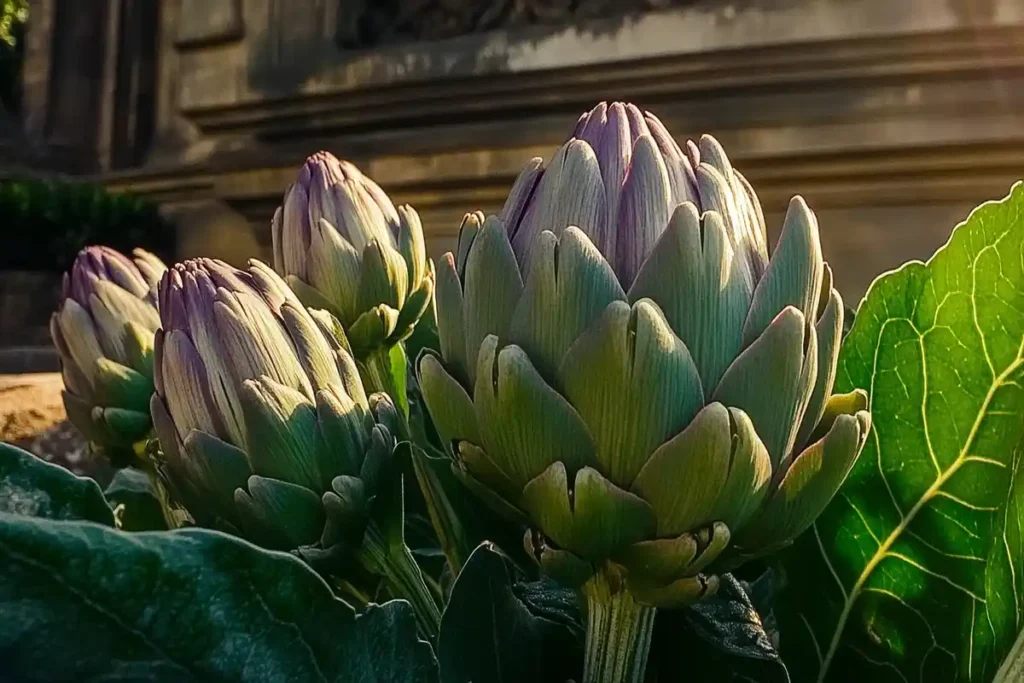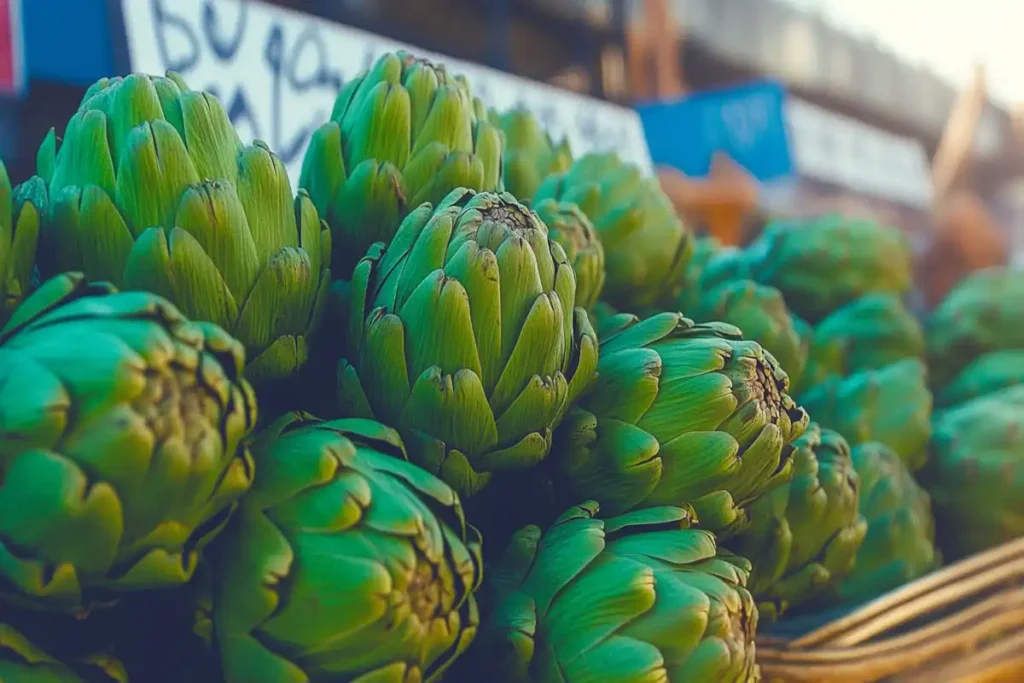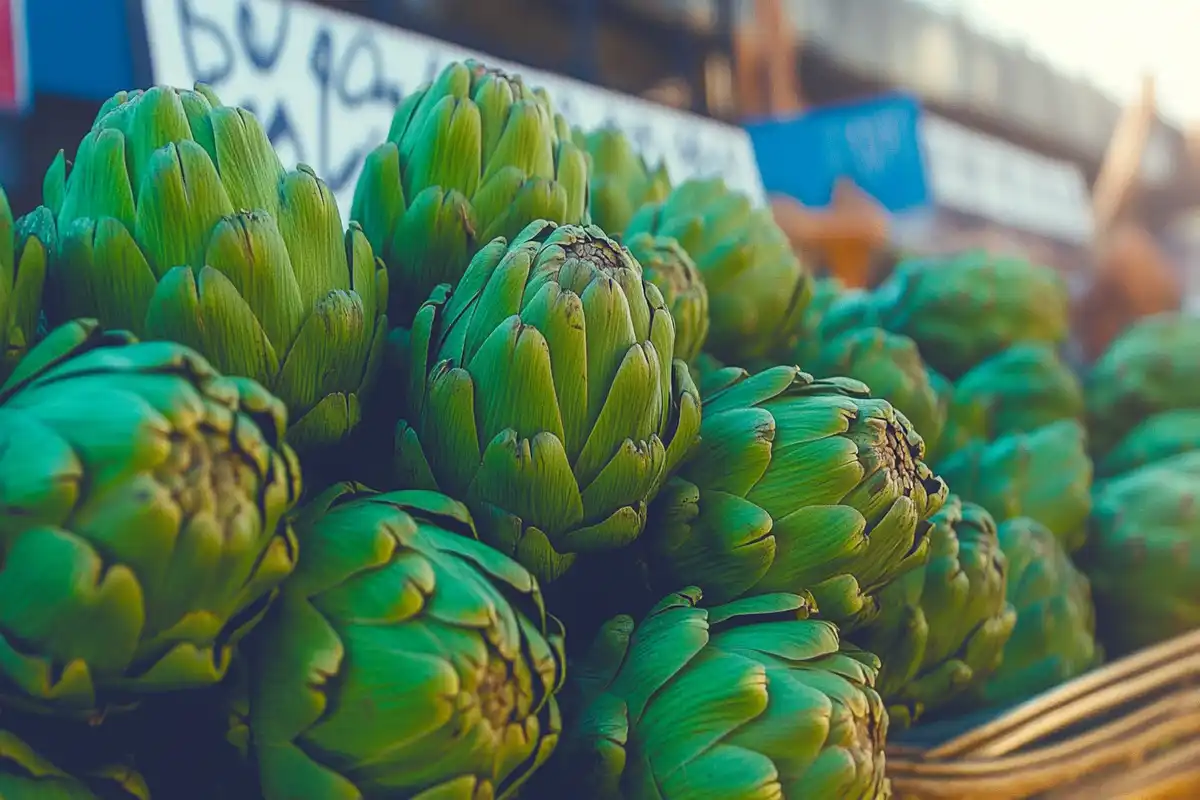Introduction: Why Artichokes Deserve More Love
If you’ve ever walked past fresh artichokes at the grocery store, wondering what to do with them, you’re not alone. I used to feel the same way. But once I discovered how versatile, delicious, and fun they are to cook with, I never looked back.

Not all artichokes are the same, though. There are dozens of varieties, each with its own size, texture, and flavor. Some are great for steaming and dipping in garlic butter, while others shine in hearty dishes. And if you’ve ever thought about growing artichokes at home, choosing the right variety makes all the difference.
Let’s explore the most popular artichoke varieties, how to cook them, and even how to grow your own at home.
What Makes Artichokes Unique?
Artichokes are technically flowers, and when left to bloom, they produce stunning purple blossoms. But most people enjoy them long before that—when they’re still in their edible bud stage.
- Taste and Texture: Artichokes have a mild, nutty flavor with a slightly earthy taste. The hearts are soft and tender, while the leaves are firm but flavorful.
- Nutritional Benefits: Packed with fiber, antioxidants, and vitamins C and K, artichokes are great for digestion and heart health.
- Cooking Versatility: They can be steamed, roasted, grilled, or stuffed, making them a staple in many kitchens.
The Most Popular Artichoke Varieties
Globe Artichokes – The Classic Choice
When most people think of artichokes, they picture the large, round, green ones—those are Globe Artichokes. These are the most common type and are widely available in grocery stores.
Best for: Steaming, boiling, grilling, and stuffing
Flavor: Mild and slightly sweet
Size: Large, can weigh up to a pound
If you’re new to cooking artichokes, Globe Artichokes are a great place to start. Just steam them, pull off the leaves, and dip them in a simple lemon-garlic sauce.
Baby Artichokes – Small but Mighty
Despite the name, Baby Artichokes aren’t a different variety—they’re just harvested earlier from the same plant. They’re smaller, more tender, and easier to cook since they don’t have the tough inner choke.
Best for: Roasting, sautéing, frying, and grilling
Flavor: Slightly sweeter and nuttier than larger artichokes
Size: Small, usually under three inches
Roasting them with olive oil, garlic, and a sprinkle of salt turns them into crispy, flavorful bites that are perfect for snacking or tossing into salads.
Purple Artichokes – A Unique Twist
If you ever come across deep-purple artichokes, don’t pass them up. These vibrant artichokes aren’t just pretty—they’re packed with flavor and slightly more tender than the standard green varieties.
Best for: Steaming, grilling, and adding color to dishes
Flavor: Richer, slightly nutty, with a hint of sweetness
Size: Medium to large, depending on the type
Popular purple artichoke varieties include Violetto, Opera, and Fiesole. Purple artichokes retain their color best when steamed or roasted, so avoid boiling them if you want to keep that beautiful hue.
Heirloom and Rare Artichoke Varieties – For the True Foodies
Castel Artichokes
One of the most tender heirloom varieties, Castel artichokes have a buttery texture and a mild, nutty taste.
Best for: Eating raw in salads or lightly steamed
Flavor: Delicate and mild
Size: Medium
Imperial Star Artichokes
If you’ve ever thought about growing your own artichokes, start with Imperial Star—it’s one of the easiest to grow at home, especially in colder climates.
Best for: Home gardeners who want a high-yield plant
Flavor: Mild and slightly sweet
Size: Medium
Unlike most artichokes that take two years to produce, Imperial Star can be grown as an annual and harvested in just one season.
Best Artichokes for Cooking Different Dishes
| Dish Type | Best Artichoke Variety |
|---|---|
| Steamed and Dipped | Globe, Purple |
| Roasted | Baby, Castel |
| Grilled | Purple, Globe |
| Fried | Baby, Fiesole |
| Stuffed | Globe, Imperial Star |
Look for tight, compact leaves and a heavy feel—this means it’s fresh and full of moisture. If the leaves squeak when squeezed, that’s a good sign.
How to Grow Artichokes at Home
Choose the Right Variety
If you live in a cold climate, go for Imperial Star or Green Globe. In warmer areas, Violetto or Purple Italian varieties thrive.
Give Them Plenty of Sun
Artichokes love the sun. Aim for at least six to eight hours of direct sunlight daily.
Be Patient—They Take Time
Artichokes aren’t a fast-growing crop. Most perennial varieties take two years to produce, but some, like Imperial Star, grow in one season.
If you want tender, delicious artichokes, harvest them before the buds open. Once they bloom, they turn into flowers and lose their texture.
Where to Buy Fresh Artichokes

Farmers’ Markets
Local farmers often grow unique heirloom varieties that you won’t find in supermarkets. If you want the freshest, most flavorful artichokes, this is the place to go.
Grocery Stores
Most large supermarkets carry Globe Artichokes year-round. During peak seasons, you might also find Baby Artichokes and Purple Artichokes.
Online Retailers
If you’re looking for heirloom seeds or fresh specialty artichokes, online stores can be a great option. Some organic farms even ship fresh artichokes straight to your door.
Common Questions About Artichokes
What’s the easiest artichoke variety to grow?
Imperial Star is the easiest for home gardeners because it grows in one season instead of two.
Can I eat artichokes raw?
Yes, Baby Artichokes and some heirloom varieties, like Castel, are tender enough to eat raw in salads.
How do I store fresh artichokes?
Keep them in the fridge, unwashed, wrapped in a damp paper towel. They stay fresh for about a week.
Why are some artichokes purple?
Purple artichokes are a different variety with higher antioxidants, which give them their rich color.
Can I freeze cooked artichokes?
Yes. Just steam them first, let them cool, and store them in an airtight container. They’ll last for up to six months.
Are artichokes good for digestion?
Absolutely. They’re high in fiber and prebiotics, which help with gut health.
Artichoke Seasonality: When Are They Best?
While you can find artichokes year-round in some grocery stores, their peak season makes a big difference in quality and flavor.
- Spring (March to June): This is prime artichoke season. The biggest and most flavorful artichokes hit the markets, especially Globe and Baby Artichokes.
- Fall (September to November): A second, smaller harvest happens in some regions, especially for heirloom varieties like Purple and Castel Artichokes.
- Winter and Summer: Some varieties, especially those grown in warm climates, are available, but they may not be as tender or fresh.
If you want the absolute best artichokes, buy them in spring or early fall when they’re naturally at their peak.
How to Prepare Artichokes for Cooking
Cooking artichokes isn’t difficult, but they do take a little prep work. Here’s how I do it:
Trimming the Leaves and Stem
- Rinse the artichoke under cold water to remove any dirt.
- Cut off about an inch from the top using a sharp knife. This removes the tough, spiky tips.
- Snip the pointy ends of each leaf with kitchen scissors for a cleaner look.
- Trim the stem, leaving about an inch. Some people peel the stem since it’s edible and tastes similar to the heart.
Removing the Choke
If you’re working with a large artichoke, you’ll need to remove the fuzzy choke in the center. The easiest way is to:
- Cut the artichoke in half lengthwise.
- Use a spoon to scoop out the fuzzy center.
- Your artichoke is now ready to cook.
For Baby Artichokes, you can skip this step since they don’t have a developed choke.
Best Cooking Methods for Artichokes
Steaming (The Easiest Method)
- Fill a pot with about two inches of water and bring it to a simmer.
- Place the artichokes in a steamer basket, cover, and steam for 25-40 minutes depending on size.
- The artichoke is done when a leaf pulls off easily and the base is tender.
Boiling (Great for Soft Texture)
- Bring a large pot of salted water to a boil.
- Add the artichokes and let them cook for 30-45 minutes.
- Drain and serve with your favorite dipping sauce.
Roasting (Best for Caramelized Flavor)

- Cut the artichoke in half and drizzle with olive oil, salt, and garlic.
- Roast at 400°F for 30-40 minutes, flipping halfway.
- The leaves get crispy, and the heart turns rich and tender.
Grilling (Adds Smoky Flavor)
- Steam or boil the artichokes for 15 minutes to soften them.
- Cut in half and brush with olive oil and lemon juice.
- Grill for 5-7 minutes per side until charred.
Grilled artichokes with a squeeze of lemon and a sprinkle of sea salt are one of my favorite summer side dishes.
Dipping Sauces for Artichokes
One of the best parts about eating artichokes is dipping the leaves into a delicious sauce. Here are some of my go-to options:
- Classic Garlic Butter: Melted butter with fresh garlic and a splash of lemon juice.
- Lemon Aioli: Mayo mixed with lemon juice, garlic, and a little Dijon mustard.
- Herb Yogurt Sauce: Greek yogurt with chopped parsley, dill, and a pinch of salt.
- Balsamic Vinaigrette: A tangy option for roasted or grilled artichokes.
Health Benefits of Artichokes
Artichokes aren’t just tasty—they’re packed with nutrients.
- High in Fiber: Helps digestion and keeps you full longer.
- Rich in Antioxidants: Supports heart health and fights inflammation.
- Liver Detox Benefits: Artichokes contain compounds that support liver function.
- Great for Blood Sugar: Low in carbs and high in fiber, making them a good option for blood sugar control.
Artichokes in Different Cuisines
Italian Cuisine
- Used in pasta dishes, like artichoke and lemon linguine.
- Fried artichokes, or Carciofi alla Romana, are a classic Roman dish.
Mediterranean Cuisine
- Marinated artichokes are popular in mezze platters.
- Grilled artichokes with olive oil and feta cheese make a great side dish.
French Cuisine
- Artichoke hearts are a staple in Provençal stews and tarts.
- Artichoke barigoule is a traditional braised dish.
Middle Eastern Cuisine
- Stuffed artichokes with rice and spices are a common dish.
- Artichoke dips, similar to hummus, use blended hearts for a creamy texture.
How to Preserve and Store Artichokes
If you buy fresh artichokes but can’t use them right away, here’s how to keep them fresh:
- Refrigerate: Wrap in a damp paper towel and store in the fridge for up to a week.
- Freeze: Steam the artichokes first, let them cool, and freeze in an airtight container.
- Pickling: Marinate artichoke hearts in olive oil and vinegar for long-term storage.
Fun Facts About Artichokes
- California produces almost 100% of the artichokes grown in the U.S.
- The world’s largest artichoke is grown in Castroville, California—also known as the “Artichoke Capital of the World.”
- Marilyn Monroe was crowned the first-ever Artichoke Queen in 1948.
- Artichokes were considered an aphrodisiac in ancient Greece and Rome.
Final Thoughts: Why You Should Try Different Artichoke Varieties
If you’ve only ever tried one type of artichoke, I highly recommend branching out. Whether you want to cook with them, grow them, or just enjoy their unique flavors, there’s an artichoke variety for everyone.
- If you want a classic, go for Globe Artichokes.
- If you love tender, easy-to-cook options, try Baby Artichokes.
- If you want something unique, Purple and Heirloom varieties are a must.
- If you’re thinking about growing your own, start with Imperial Star.
Experiment with different types, try new recipes, and see which ones become your favorites. Once you start cooking with fresh artichokes, you’ll never go back to the canned stuff again.

